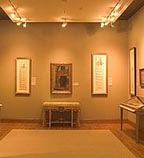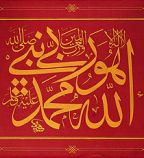Sakip Sabanci Museum
 The Sabanci University Sakip Sabanci Museum is a private fine arts museum in Istanbul, Turkey, dedicated to calligraphic art, religious and state documents, as well as paintings of the Ottoman era. The museum was founded by Sakip Sabanci, and was opened in June 2002. Aside from permanent exhibitions, the museum also hosts national and foreign temporary exhibitions and, hosts cultural events on the weekends.
The Sabanci University Sakip Sabanci Museum is a private fine arts museum in Istanbul, Turkey, dedicated to calligraphic art, religious and state documents, as well as paintings of the Ottoman era. The museum was founded by Sakip Sabanci, and was opened in June 2002. Aside from permanent exhibitions, the museum also hosts national and foreign temporary exhibitions and, hosts cultural events on the weekends.
Sabancı University's Sakıp Sabancı Museum is located in Emirgan, at one of Istanbul's oldest settlements on the Bosphorus.
In 1927 Prince Mehmed Ali Hasan of the Hidiv family of Egypt commissioned the Italian architect Edouard De Nari to build the villa, now the museum's main building, and it was used as a summer house for many years by various members of the Hidiv family; for a short time it also served as the Montenegran Embassy.
After the mansion was purchased in 1950 by industrialist Hacı Ömer Sabancı from Prince Iffet, a member of the Hidiv family, it came to be known as "Atlı Köşk", The Horse Mansion, because of the statue of a horse (purchased in the same year) that was installed in the garden; the statue is the 1864 work of the French sculptor Louis Doumas.
A second horse sculpture on the grounds of Atlı Köşk is the cast of one of the four horses taken from Sultanahmet square in Istanbul when it was looted by Crusaders during the fourth Crusade in 1204 and removed to the Basilica of San Marco in Venice.
After the death of Hacı Ömer Sabancı in 1966 Atlı Köşk began to be used permanently as a home by Sakıp Sabancı, the eldest of the family, and for many years housed Sakıp Sabancı's rich collection of calligraphy and paintings. In 1998, together with its collection and furnishings, the mansion was allocated to Sabancı University to be transformed into a museum.
With the annex of a modern gallery, the exhibition areas of the museum opened to visitors in 2002; with a further extension of the layout in 2005, the technical level of the museum reached international standards.
Today Sabancı University Sakıp Sabancı Museum presents a versatile museological environment with its rich permanent collection, the comprehensive temporary exhibitions that it hosts, its conservation units, model educational programmes and the various concerts, conferences and seminars held there.
The Sakıp Sabancı Collection of Ottoman Calligraphy presents at a glance examples of 500 years of the art of Ottoman calligraphy. The Collection includes rare manuscript copies of the Holy Qur’an, individual inscriptions as well as assembled albums, panels, descriptions of the attributes of the Prophet, official documents such as decrees and grants of appointment, privilege and income, as well as tools used in the practice of this art. The Collection is displayed on the upper storey of the Atlı Köşk mansion.
Sabancı University
Sakıp Sabancı Museum
Address :
Sakıp Sabancı Cad. No:42
Emirgan 34467
İstanbul
Telephone : +90 212 277 22 00
Fax : +90 212 229 49 14
E-mail address : muze@sabanciuniv.edu
Site: http://sabanciuniv.edu
Back to listCalligraphy is a remedy and mental gymnastics.






